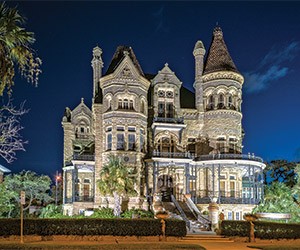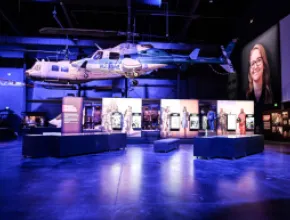First populated by Native Americans and then discovered by Europeans in the early 16th century, Galveston Island’s remarkable resume effectively starts with Spanish explorer Jose de Evia’s visit in 1786.
Commissioned by Spanish military leader Bernardo de Galvez to chart the Gulf Coast from west Florida to Mexico, Evia, a Spanish naval officer, named the island Galvez-town in his patron’s honor.
Before its devastation by the Hurricane of 1900, the city had evolved into a leading center of finance, shipping and trade, producing a number of Texas originals, including its first naval base, hospital, opera house, telephone and electric lighting.
Reborn as a tourist destination in the 1920s, Galveston has since proven a study in resiliency, weathering cultural shifts and stagnation en route to becoming a vibrant visitor and convention destination layered with guest attractions and amenities.
“Galveston is a great meetings destination for those who want to mix business with pleasure,” says Meg Winchester, director of the Galveston Island CVB. “The island offers the charm and adventure of a historic beach town while offering the convenience of state-of-the-art meeting facilities, amenities and cost-savings.”
Invested with the island’s pioneering, persistent spirit, here are three quintessential slices of the multifaceted Galveston experience.PageBreak
The Strand National Historic Landmark District
Eclipsed by Houston as a seaport in 1917, Galveston spent the next four decades as a den of debauchery before Texas Rangers axed “Sin City” in 1957. Decline set in, until Galveston-born oilman George Mitchell began investing in the revitalization of the city’s downtown Strand district, then a skid row, in the early 1980s.
Mitchell had a ready template for renewal. One of several historic districts in the city, the 36-block Strand District—its five-block main thoroughfare considered the “Wall Street of the South” in its heyday—contained one of the largest and best-preserved concentrations of Victorian commercial architecture in the country. Mitchell’s galvanizing efforts would produce what is today the beating heart of Galveston’s visitor trade.
Hopping with restaurants, boutiques, antique shops, art galleries, museums and more, the Strand, which serves as the parade route for the city’s wildly popular annual Mardi Gras festival, is emblematic of how Galveston has successfully leveraged its architectural, cultural and maritime heritage. Through the efforts of the Galveston Historical Foundation, the city boasts more than 2,000 buildings listed on the National Register of Historic Places.
The Strand’s iron-front Victorians make splendid corridors for touring the district, which offers a number of destinations for group outings and events. Unique venues include the Ocean Star Offshore Drilling Rig & Museum, located inside a retired oil rig; the Grand 1894 Opera House, which can host private performances for groups; and at the head of the Strand, the event-capable Railroad Museum, housing one of the largest railroad collections in the Southwest. PageBreak
Moody Gardens
Another entrepreneur integral to Galveston’s renaissance was William Lewis Moody Jr. Born three hours north of the city in Fairfield, Texas in 1865, Moody moved to Galveston in 1886 to work at his father’s cotton business. After founding the private W.L. Moody bank in 1899, he built a business empire that included newspapers, ranches, hotels (including Galveston’s historic Hotel Galvez, now owned by George Mitchell, who turns 94 this May) and the American National Insurance Company.
In 1942, Moody and his wife Libbie created the Moody Foundation “to benefit in perpetuity present and future generations of Texans.” Galveston would be a prime beneficiary. Capital grants from the foundation, which is valued at around $1 billion today, were instrumental in enabling the Galveston Historical Foundation to save buildings in the Strand and other historic neighborhoods. Another project was the purchase and restoration of the 1877 Tall Ship Elissa, brought from Greece and among the city’s leading attractions.
In the mid-1980s, the Moody Foundation funded the creation of a visionary facility that would boost year-round tourism to Galveston while also providing care for people with traumatic head injury. Multiple development phases later, and Moody Gardens has evolved into one of the premier leisure, convention and educational facilities in the Southwest.
The 242-acre complex includes the 428-room Moody Gardens Hotel, Spa and Convention Center, offering 103,000 square feet of versatile function and expo space under one roof. Moody Gardens Hotel in the midst of a $20 million refurbishment. Instantly recognizable for its striking pyramid-shaped buildings, the complex also includes the newly redesigned Rainforest Pyramid, a one-acre rainforest environment containing free-roaming birds and other animals, the Discovery Pyramid of science exhibitions, 3-D and 4-D theaters, a waterpark, golf and one of the country’s largest aquariums. PageBreak
Sea and Sand
With 32 miles of beaches, Galveston Island provides great opportunities for outdoor events and outings on the sand.
For starters, there is the simple pleasure of relaxing along Galveston’s 10.4-mile-long seawall and watching the parade of humanity along the world’s longest continuous sidewalk. For more active engagements, groups can call on a range of suppliers for activities such as team building, nature excursions, fishing trips, boat tours and more.
Earlier this year, Travel Channel named Galveston Island State Park one of the top five best beaches on the Gulf Coast—the only Texas beach to make the list. One of Galveston’s premier ecological and historical treasures, the park offers programs including ranger-led tours and equipment rentals for fishing. Via the Friends of Galveston Island State Park, other opportunities include volunteering, kayak tours, field trips and visits to the Nature Center.
Galveston Historical Foundation affiliate and CVB partner Galveston Island Tours provides a range of group activities, from intimate sunset dining adventures and corporate dinner yacht cruises to beachside shrimp boils and sandcastle-building competitions.
Teeming with more than 100 species of fish, Galveston’s waters are an angler’s paradise. Dotted with marinas, Galveston Bay is home to multiple operators offering deep-sea and bay fishing, along with party boats and private charters for group excursions. Located on Pier 21 in front of the Harbor House Hotel, BayWatch Dolphin Tours takes groups on dolphin-spotting explorations of historic Galveston Harbor.
An island tradition since 1911, family-owned Gaido’s Seafood Restaurant is a historic choice for Gulf-facing business and social gatherings.
The 250-room San Luis Resort, Spa and Conference Center is a premier beachfront group choice that offers 40,000 square feet of IACC-accredited conference space and is also home to the Galveston Island Convention Center. The property is undergoing a refurbishment.
Regular Meetings Focus contributor Jeff Heilman returns to Galveston and other Lone Star locales later this year for his sixth consecutive edition of Meetings Focus Texas.







